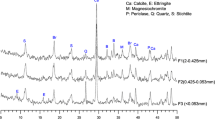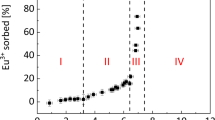Abstract
Synchrotron-based X-ray absorption spectroscopy has been used to determine the chemical speciation of Np sorbed on Opalinus Clay (OPA, Mont Terri, Switzerland), a natural argillaceous rock revealing a micro-scale heterogeneity. Different sorption and diffusion samples with Np(V) were prepared for spatially resolved molecular-level investigations. Thin sections of OPA contacted with Np(V) solution under aerobic and anaerobic conditions as well as a diffusion sample were analysed spatially resolved. Micro-X-ray fluorescence (μ-XRF) mapping has been used to determine the elemental distributions of Np, Fe and Ca. Regions of high Np concentration were subsequently investigated by micro-X-ray absorption fine structure spectroscopy to determine the oxidation state of Np. Further, micro-X-ray diffraction (μ-XRD) was employed to gain knowledge about reactive crystalline mineral phases in the vicinity of Np enrichments. One thin section was also analysed by electron microprobe to determine the elemental distributions of the lighter elements (especially Si and Al), which represent the main elements of OPA. The results show that in most samples, Np spots with considerable amounts of Np(IV) could be found even when the experiments were carried out in air. In some cases, almost pure Np(IV) LIII-edge X-ray absorption near-edge structure spectra were recorded. In the case of the anaerobic sample, the μ-XRF mapping showed a clear correlation between Np and Fe, indicating that the reduction of Np(V) is caused by an iron(II)-containing mineral which could be identified by μ-XRD as pyrite. These spatially resolved investigations were complemented by extended X-ray absorption fine structure measurements of powder samples from batch experiments under aerobic and anaerobic conditions to determine the structural parameters of the near-neighbour environment of sorbed Np.





Similar content being viewed by others
References
Hoth P, Wirth H, Reinhold K, Bräuer V, Krull P, Feldrappe H (2007) Endlagerung radioaktiver Abfälle in tiefen geologischen Formationen Deutschlands – Untersuchung und Bewertung von Tongesteinsformationen. BGR Bundesanstalt für Geowissenschaften und Rohstoffe, Hannover
NAGRA (2002) Projekt Opalinuston–Synthese der geowissenschaftlichen Untersuchungsergebnisse, Entsorgungsnachweis für abgebrannte Brennelemente, verglaste hochaktive sowie langlebige mittelaktive Abfälle. Technical Report NTB 02-03, NAGRA Nationale Genossenschaft für die Lagerung radioaktiver Abfälle, Wettingen
OECD (2006) Safety of geological disposal of high-level and long-lived radioactive waste in France—an international peer review of the “Dossier 2005 Argile” concerning disposal in the Callovo-Oxfordian formation. NEA No. 6178, OECD Organisation for Economic Co-operation and Development
Gompper K (2000) Zur Abtrennung langlebiger Radionuklide. In: Radioaktivität und Kernenergie. Forschungszentrum Karlsruhe, p.153
Amayri S, Jermolajev A, Reich T (2011) Neptunium(V) sorption on kaolinite. Radiochim Acta 99:349–357
Bradbury MH, Baeyens B (2006) Modelling sorption data for the actinides Am(III), Np(V) and Pa(V) on montmorillonite. Radiochim Acta 94:619–625
Fröhlich DR, Amayri S, Drebert J, Reich T (2011) Sorption of neptunium(V) on Opalinus Clay under aerobic/anaerobic conditions. Radiochim Acta 99:71–77
Fröhlich DR, Amayri S, Drebert J, Reich T (2012) Influence of temperature and background electrolyte on the sorption of neptunium(V) on Opalinus Clay. Appl Clay Sci (in press)
Kozai N, Onuki T, Muraoka S (1993) Sorption characteristics of neptunium by sodium-smectite. J Nuc Sci Technol 30:1153–1159
Mironenko MV, Malikov DA, Kulyako YM, Myasoedov BF (2006) Sorption of Np(V) on kaolinite from solutions of MgCl2 and CaCl2. Radiochemistry 48:62–68
Mironenko MV, Malikov DA, Kulyako YM, Myasoedov BF (2006) Sorption of Np(V) on montmorillonite from solutions of MgCl2 and CaCl2. Radiochemistry 48:69–74
Nagasaki S, Tanaka S (2000) Sorption equilibrium and kinetics of NpO +2 on dispersed particles of Na-montmorillonite. Radiochim Acta 88:705–709
Niitsu Y, Sato S, Ohashi H, Sakamoto Y, Nagao S, Ohnuki T, Muraoka S (1997) Effects of humic acid on the sorption of neptunium(V) on kaolinite. J Nuc Mater 248:328–332
Schmeide K, Bernhard G (2010) Sorption of Np(V) and Np(IV) onto kaolinite: effects of pH, ionic strength, carbonate and humic acid. Appl Geochem 25:1238–1247
Turner DR, Pabalan RT, Bertetti FP (1998) Neptunium(V) sorption on montmorillonite: an experimental and surface complexation modelling study. Clays Clay Miner 46:256–269
Kozai N, Inada K, Kozaki T, Sato S, Ohashi H, Banba T (2001) Apparent diffusion coefficients and chemical species of neptunium(V) in compacted Na-montmorillonite. J Contam Hydrol 47:149–158
Tachi Y, Nakazawa T, Ochs M, Yotsuji K, Suyama T, Seida Y, Yamada N, Yui M (2010) Diffusion and sorption of neptunium(V) in compacted montmorillonite: effects of carbonate and salinity. Radiochim Acta 98:711–718
Wu T, Amayri S, Drebert J, Van Loon LR, Reich T (2009) Neptunium(V) sorption and diffusion in Opalinus Clay. Environ Sci Technol 43:6567–6571
Reich T, Reich TY, Amayri S, Drebert J, Banik NL, Buda RA, Kratz JV, Trautmann N (2007) Application of XAFS spectroscopy to actinide environmental science. AIP Conf Proc (X-Ray Absorption Fine Structure (XAFS13)) 882:179–183
Wieland E, Macé N, Dähn R, Kunz D, Tits J (2010) Macro- and micro-scale studies on U(VI) immobilization in hardened cement paste. J Radioanal Nucl Chem 286:793–800
Mandaliev P, Dähn R, Wehrli B, Wieland E (2009) Macro- and microspectroscopic study of Nd(III) uptake mechanism in hardened cement paste. Environ Sci Technol 43:8462–8468
Vespa M, Dähn R, Grolimund D, Wieland E, Scheidegger AM (2007) Co speciation in hardened cement paste: a macro- and micro-spectroscopic investigation. Environ Sci Technol 41:1902–1908
Vespa M, Dähn R, Gallucci E, Grolimund D, Wieland E, Scheidegger AM (2006) Microscale investigations of Ni uptake by cement using a combination of scanning electron microscopy and synchrotron-based techniques. Environ Sci Technol 40:7702–7709
Duff MC, Hunter DB, Triay IR, Bertsch PM, Kitten J, Vaniman DT (2001) Comparison of two micro-analytical methods for detecting the spatial distribution of sorbed Pu on geological materials. J Contam Hydrol 47:211–218
Duff MC, Hunter DB, Triay IR, Bertsch PM, Reed DT, Sutton SR, Shea-McCarthy G, Kitten J, Eng P, Chipera SJ, Vaniman DT (1999) Mineral association and average oxidation states of sorbed Pu on tuff. Environ Sci Technol 33:2163–2169
Denecke MA, Brendebach B, De Nolf W, Falkenberg G, Janssens K, Simon R (2009) Spatially resolved micro-X-ray fluorescence and micro-X-ray absorption fine structure study of a fractured granite bore core following a radiotracer experiment. Spectrochim Acta B 64:791–795
Kaszuba JP, Runde WH (1999) The aqueous geochemistry of neptunium: dynamic control of soluble concentrations with applications to nuclear waste disposal. Environ Sci Technol 33:4427–4433
Van Loon LR, Soler JM, Bradbury MH (2003) Diffusion of HTO, 36Cl− and 125I− in Opalinus Clay samples from Mont Terri: effect of confining pressure. J Contam Hydrol 61:73–83
Borca CN, Grolimund D, Willimann N, Meyer B, Jefimovs K, Vila-Comamala J, David C (2009) The microXAS beamline at the Swiss Light source: towards nano-scale imaging. J Phys: Conf Ser 186:012003/1-3
Ravel B, Newville M (2005) ATHENA, ARTEMIS, HEPHAESTUS: data analysis for X-ray absorption spectroscopy using IFEFFIT. J Synchrotron Rad 12:537–541
Roßberg A, Reich T, Bernhard G (2003) Complexation of uranium(VI) with protocatechuic acid—application of iterative transformation factor analysis to EXAFS spectroscopy. Anal Bioanal Chem 376:631–638
Reich T, Bernhard G, Geipel G, Funke H, Hennig C, Rossberg A, Matz W, Schell N, Nitsche H (2000) The Rossendorf Beam Line ROBL—a dedicated experimental station for XAFS measurements of actinides and other radionuclides. Radiochim Acta 88:633–637
Lande J, Webb S (2007) The area diffraction machine. Stanford Synchrotron Radiation Laboratory, Stanford, http://www.areadiffractionmachine.googlecode.com. 19.07.2012
Matz W, Schell N, Bernhard G, Prokert F, Reich T, Claußner J, Oehme W, Schlenk R, Dienel S, Funke H, Eichhorn F, Betzl M, Pröhl D, Strauch U, Hüttig G, Krug H, Neumann W, Brendler V, Reichel P, Denecke MA, Nitsche H (1999) ROBL—a CRG beamline for radiochemistry and materials research at the ESRF. J Synchrotron Rad 6:1076–1085
George GN, Pickering IJ (2000) EXAFSPAK: A suite of computer programs for analysis of X-ray absorption spectra. Stanford Synchrotron Radiation Laboratory, Stanford
Ankudinov AL, Bouldin, CE, Rehr JJ, Sims J, Hung H (2002) Parallel calculation of electron multiple scattering using Lanczos algorithms. Phys Rev B 65:104107/1–11
Demartin F, Gramaccioli CM, Pilati T (1992) The importance of accurate crystal structure determination of uranium minerals. II. Soddyite (UO2)2(SiO4)∙2H2O. Acta Cryst C48:1–4
Benedict U, Dabos S, Dufour C, Spirlet JC, Pagès M (1986) Neptunium compounds under high pressure. J Less-Common Met 121:461–468
Ankudinov AL, Ravel B, Rehr JJ, Conradson SD (1998) Real-space multiple-scattering calculation and interpretation of x-ray-absorption near-edge structure. Phys Rev B 58:7565–7576
Beall GW, Allard B, O’Kelly GD (1980) An autoradiographic study of actinide sorption in climax stock granite. Oak Ridge National Laboratory, Oak Ridge, ORNL-5617
Clark DL, Conradson SD, Ekberg SA, Hess NJ, Neu MP, Palmer PD, Runde W, Tait CD (1996) EXAFS studies of pentavalent neptunium carbonato complexes. Structural elucidation of the principal constituents of neptunium in groundwater environments. J Am Chem Soc 118:2089–2090
Dähn R, Scheidegger AM, Manceau A, Curti E, Baeyens B, Bradbury MH, Chateigner D (2002) Th uptake on montmorillonite: a powder and polarized extended X-ray absorption fine structure (EXAFS) study. J Colloid Interface Sci 249:8–21
Östhols E, Manceau A, Farges F, Charlet L (1997) Adsorption of thorium on amorphous silica: an EXAFS study. J Colloid Interface Sci 194:10–21
Sylwester ER, Hudson EA, Allen PG (2000) The structure of uranium (VI) sorption complexes on silica, alumina, and montmorillonite. Geochim Cosmochim Acta 64:2431–2438
Acknowledgments
This work was financed by the Federal Ministry of Economics and Technology (BMWi) under contract no. 02E10166 and Actinet-I3 under contract no. 232631. Daniel Fröhlich has been supported by a fellowship of DFG-GRK 826. The synchrotron-based measurements were performed at the microXAS beamline of the Swiss Light Source, Paul Scherrer Institut, Villigen, Switzerland, and the Rossendorf Beamline of the European Synchrotron Radiation Facility, Grenoble, France. We are grateful to Camelia Borca at SLS as well as to Dipanjan Banerjee, Christoph Hennig, André Roßberg and Andreas Scheinost at ROBL for their support of the synchrotron measurements. We thank Nora Groschopf (Institute of Geosciences, Johannes Gutenberg-Universität Mainz) for XRF analysis and Dr. Christian Marquardt (Institute for Nuclear Waste Disposal, Karlsruher Institut für Technologie) for providing the OPA samples. Maik Biegler (Max-Planck-Institut für Chemie, Mainz) is acknowledged for the preparation of the thin sections.
Author information
Authors and Affiliations
Corresponding author
Additional information
Published in the topical collection Modern Aspects on Elemental Speciation with guest editors Thorsten Hoffmann and Klaus G. Heumann.
Electronic supplementary material
Below is the link to the electronic supplementary material.
ESM 1
(PDF 283 kb)
Rights and permissions
About this article
Cite this article
Fröhlich, D.R., Amayri, S., Drebert, J. et al. Speciation of Np(V) uptake by Opalinus Clay using synchrotron microbeam techniques. Anal Bioanal Chem 404, 2151–2162 (2012). https://doi.org/10.1007/s00216-012-6290-2
Received:
Revised:
Accepted:
Published:
Issue Date:
DOI: https://doi.org/10.1007/s00216-012-6290-2




